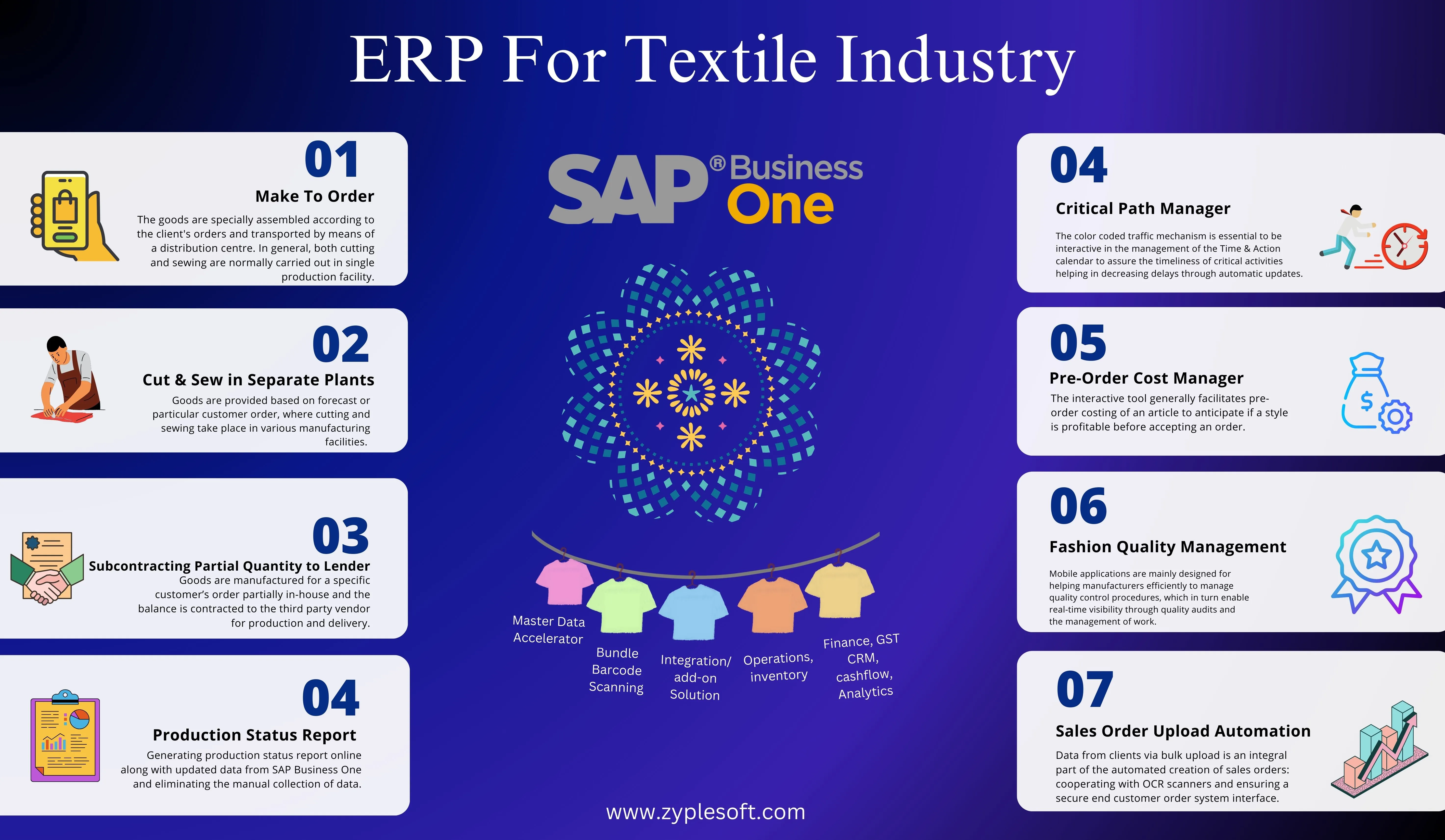
Textile manufacturing, which had been traditionally considered as a crafts work, is now becoming an engineering activity that uses different technologies and fibers to design and develop textiles. The main challenging areas of this industry are maintaining the stock of dyes, managing manpower, maintenance of machines, and much more. It provides an integrated application as a solution solving all the major challenges faced by this industry therefore making the business processes smooth and efficient.
The goods are specially assembled according to the client's orders and transported by means of a distribution centre. In general, both cutting and sewing are normally carried out in single production facility.
Goods are provided based on forecast or particular customer order, where cutting and sewing take place in various manufacturing facilities.
Goods are manufactured for a specific customer’s order partially in-house and the balance is contracted to the third party vendor for production and delivery.
Generating production status report online along with updated data from SAP Business One and eliminating the manual collection of data.
It decides on the good business between the manufacturer and the vendor, which results from the vendor's markup. At the same time, it minimizes the value of the goods and the amount to be paid.
The color coded traffic mechanism is essential to be interactive in the management of the Time & Action calendar to assure the timeliness of critical activities helping in decreasing delays through automatic updates
The interactive tool generally facilitates pre-order costing of an article to anticipate if a style is profitable before accepting an order.
Mobile applications are mainly designed for helping manufacturers efficiently to manage quality control procedures, which in turn enable real-time visibility through quality audits and the management of work.
Comfortable, fast, and accurate to maintain large fashion master data, along with proper authorization for every department, leverage integrated data from existing systems.
Data from clients via bulk upload is an integral part of the automated creation of sales orders: cooperating with OCR scanners and ensuring a secure end customer order system interface.
Barcode creation and allocation for production kit bundles are provided with track protection of scanning barcodes and recording quality per bundle.
Data integration is managed and duplication of data is avoided for several departments.. Further, pre and post-production costing mechanism permits to render the accurate price and tracks the gains on every order.
This module helps you to scale your production processes by getting accurate data about inbound and outbound shipments, item location and inventory.
This module helps you to control and manage the daily operations with quick access to crucial information such as alert, approvals, currency exchange rates, internal mails and import-export values.
This module helps you to manage everything right from item listing, prices, special elements in purchase and sales. Run regular inventory updates and check accessibility and manage quality standards with special pricing.
This module helps you to get complete bunch of tools to simplify your accounting operations. You can automate everyday financial activities such as maintenance of ledger, journal, taxes and allow your business with multi-currency transactions.
This module helps you to constantly keep in touch with the customers to maintain better relations. It enables you to know their demands through feedback.
SAP Business One Analytics and Reporting provides strong foundation to establish, analyze and measure your business performance for smart decision-making.
These are the five main advantages of SAP Business One that make it valuable to entrepreneurs in the textile industry
Textile industry supply chains often stretch across multiple international borders with growing shipping expenses. Business leaders must initiate ways of savings wherever they can in their supply chain without sacrificing quality.
Simplified manufacturing processes are a must for an industry like textile that moves very faster. This industry demands an integrated response to enhance demand fluctuations, last-minute raw materials hiccups and of course the need to keep up with the competition rather than simply responding to obstacles.
Implementing ERP software generally comes with a reputation for enormous up-front expenditures and long, painful implementation periods. On the other hand, SAP Business One is the most economical and easiest to implement.
Returns are very usual in the textile industry. B2C apparel businesses need to be equipped to handle a stable stream of returns, particularly around holidays, and this can prove a taxing task for systems that aren’t up to the job. It really matters to the customers on how businesses manage these returns.
Adopting an omnichannel strategy is a requirement for any business that wants to grow in today’s commercial environment, particularly B2C retail organizations. Online presence, selling through online retailers is a part of the new regular of omnichannel retail commerce. That means every feature of the system must work together smoothly to deliver responsive performance and a great customer experience.
Here are the most common problems faced by textile industry:
There are multiple processes involved in the textile industry. What is more challenging is the need for synchronization between different departments like fabric, sampling, cutting, sewing, QA, finishing, packaging, accounts, and so on.
Reporting in real-time is not possible because by the time data reaches the analyst, it is already obsolete.